#junko nakanishi
Text
Happy 60th anniversary Mothra vs Godzilla!


Logo from here
#Godzilla#Mothra#twin larvae#Mothra egg#Mothra larva#1964#mothra vs. godzilla#mothra vs godzilla#shobijin#godzilla vs the thing#akira takarada#Ichiro Sakai#Yuriko Hoshi#Junko Nakanishi#hiroshi koizumi#shunsuke miura#emi ito#Yumi ito#the peanuts#60’s movies#60’s#Godzilla 70th anniversary#ishiro honda#shinichi sekizawa#akira ifukube#Yuji koseki#eiji tsuburaya#favorite Godzilla movie
6 notes
·
View notes
Text
youtube
鍵はかえして! (Kagi wa Kaeshite!) by Junko Ohashi / 大橋純子
Album: Feeling Now
Year: 1974
Label: Philips → Universal Music Japan
Lyrics: Rei Nakanishi / なかにし礼
Music: Tadao Inoue / 井上忠夫
#japanese new music#junko ohashi#1974#philips#universal music japan#rei nakanishi#tadao inoue#70s soul#subcategory: soul#admin fave#my channel#大橋純子#Youtube
1 note
·
View note
Text
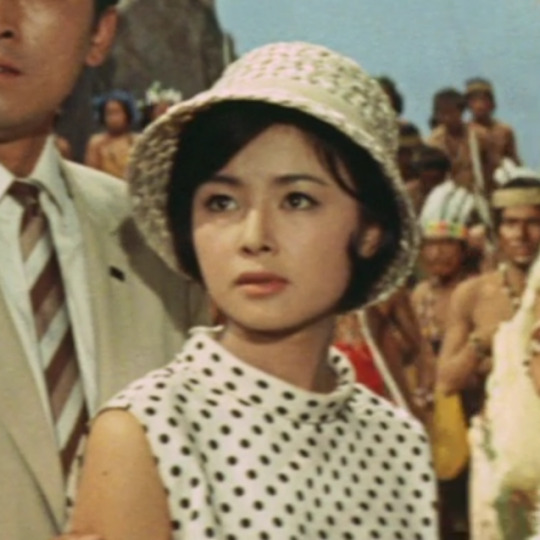

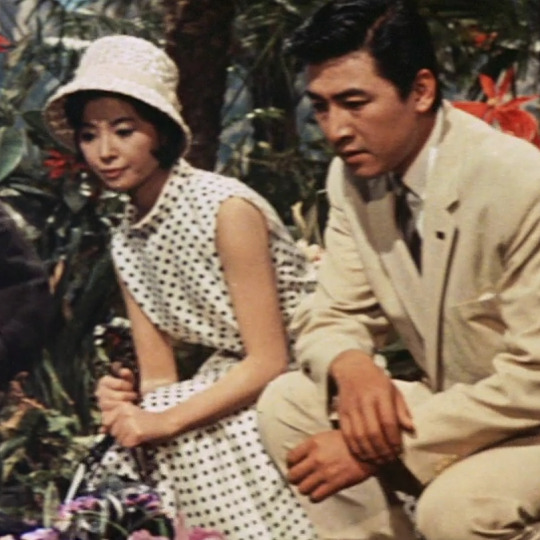

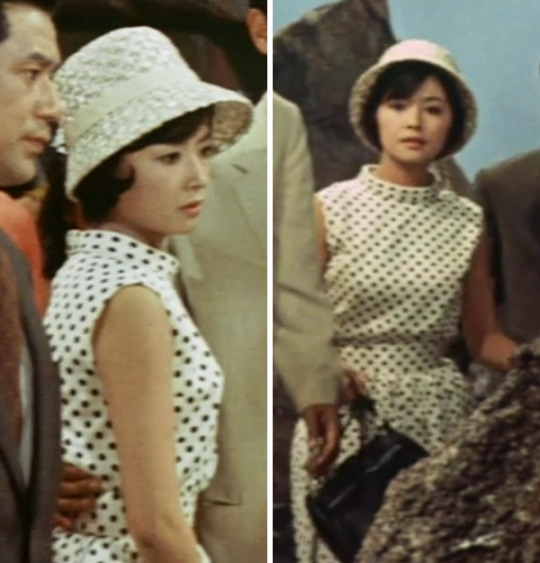


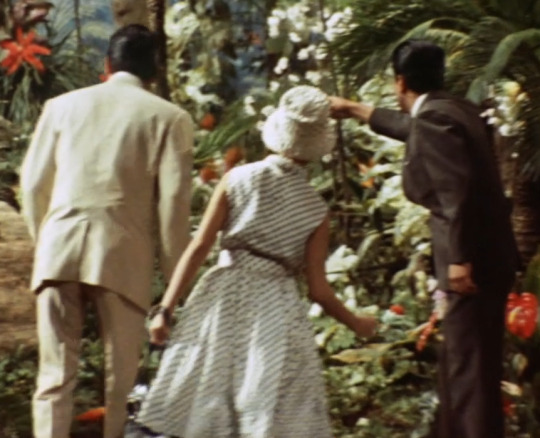
One Dress a Day Challenge
Black and White October
Mothra vs. Godzilla (Mosura tai Gojira) / Yuriko Hoshi as Junko Nakanishi
This classic polka-dotted sleeveless dress is appropriate for virtually any occasion, from meetings with the chief of an isolated tribe to negotiating with diminutive fairies. With its standing collar, A-line skirt, and belt of the same material, it wouldn't look out of place in any decade from the 1950s forward.
What's particularly impressive is that Junko somehow manages to wear it under a suit of oilskins including pants (see below) without getting it impossibly wrinkled! (Either that, or she folded it up very small and carried it in her purse.)
Junko accessorizes with a white, bucket-shaped straw hat, black shoes, and a black purse.
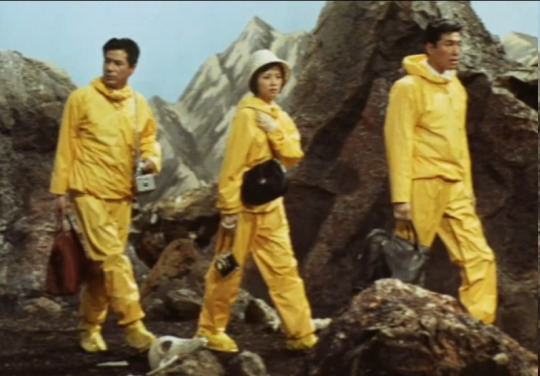
#mothra vs. godzilla#black and white october#yuriko hoshi#one dress a day challenge#one dress a week challenge#movie costumes#1964 movies#1964 films#1960s fashion#1960s style#japanese movies#japanese films#japanese cinema#mothra x godzilla#mosura#60s style#60s fashion#hoshi yuriko#mosura tai gojira#mothra versus godzilla#junko nakanishi#black and white redux
51 notes
·
View notes
Text
Mothra vs. Godzilla, 1964

Mothra, Mothra, Mothra! Ishiro Honda once again delivers a monster masterpiece, Mothra vs. Godzilla. The American version is Godzilla vs. the Thing
We were first introduced to the island god in 1961’s box office hit, Mothra. The giant moth is the peaceful protector of Infant Island and the earth if danger arises. We also met the twin fairies and the natives who guard their protector passionately. The Mothra song sung by the fairies is one of the most recognized tunes in the world (you can download it on iTunes).
Honda intended to show the kind of destruction nuclear testing can do, Infant Island in the movie, however, an undertone of industry greed surfaced as the main message that money and fame could corrupt men.
The Story
A typhoon, strikes Karuta Beach. A reporter, Ichiro Saki, and his photographer, Junko Nakanishi, go to Shizunoura to get photos of what damages was caused by the typhoon. Junko discovers an object floating in the water and wants to photograph it, then they receive word about a giant egg that washed ashore. They leave their location to investigate it and take the strange object with them.
Saki and Junko meet Professor Miura who is there examining the egg. A shady businessman named Kumayama stops Miura from working claiming the egg belongs to him. When asked how that is possible, the seaside village leader claims the egg washed onto their shore and it’s rightfully theirs, so he sold it to Kumayama for a large sum of money. Completely taken aback by the situation, Miura reluctantly leaves.
Saki, Junko, and Muira to a nearby hotel to discuss the egg situation. They see Kumayama sneak to a room; suspicious, Saki follows him to find out what’s going on. In the room, Kumayama meets with a financial investor, Jiro Torahata, about the egg. Pleased to know the egg now belonged to him, Torahata says he will construct a giant glass incubator to encase the egg and charge people fees to view it. The men are interrupted by twin fairies from Infant Island, or Mothra Island in the American version, who say the egg is rightfully theirs and they want it back. Torahata and Kumayama try to capture the twins, but they escape. Saki enters the room upon hearing the ruckus and recognizes Torahata.
Saki regroups with Junko and Miura and tells them about Torahata’s background about being a wealthy investor who owns Product Enterprises. The fairies come forward and introduce themselves. They explain that they pleaded with Torahata and Kumayama to return Mothra’s egg, The Thing in the American version. The fairies take the three to see Mothra and they agree to help by persuading the bad men to return the egg.
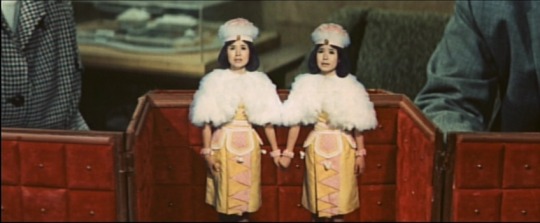
The following day, Saki, Junko, and Muira visit Kumayama and Torahata and explain to them the egg doesn’t belong to them and it rightfully belongs to Mothra. The bad men sarcastically tell Saki to get a power of attorney from Mothra to convince them the egg is The Thing’s property. Junko opens a decorative box to reveal the fairies inside. They ask the bad men to return the egg to them, but the response they get is an offer to buy them from Saki for a large sum of money. Saki and his friends leave feeling defeated. They regroup in a bar to come up with another plan to get the egg back. Realizing probability is hopeless, the fairies return home on Mothra’s back.
The village fishermen visit Kumayama with demands for money owed them for the egg and land rent. Kumayama turns them away telling them he’ll pay them later. He calls Torahata to tell him to pay what he owes, but said he won’t because he needs the money, instead, he convinces Kumayama to accept a loan he can repay from his share in the company stock.
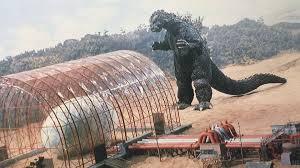
The following day, Saki and Junko visit Muira at his lab. Before they’re allowed in, they’re “washed” down because they were contaminated with radioactivity from the object Junko found in the water at the beach. Muira returns to examine the egg with Saki and Junko to check for radioactivity, but he’s stopped. Saki looks for Junko and finds looking at a beach some distance away. He calls her to leave but she refuses and tells him she sees the ground “bubbling.” Suddenly, Godzilla emerges and everyone runs to safety.
Saki and his friends fly to Mothra Island to ask for help; the natives refuse to because they wouldn’t return the egg. However, Mothra calls out to the twin fairies and they ask it fight Godzilla. Mothra agrees to and Saki and the team return home.
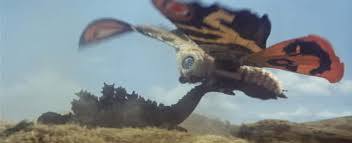
Meanwhile, the defense force devises a defense strategy to defeat Godzilla hoping Mothra comes to their aid. Godzilla made it to the egg and begins destroying the incubator with its tail. He starts on the egg, and then Mothra arrives and a battle ensues.

The fight is intense, Mothra uses all its energy and flies away to die atop the egg. The fairies take Saki, Junko, and Muira to the egg for it to hatch. When they arrive, Mothra has died and the twins begin chanting a song to encourage the larva to hatch. Surprisingly, twin larvae emerge and they fight Godzilla with their webbing. After the battle, the caterpillars swim back to Mothra Island.
The Reception
Mothra vs. Godzilla was released in Japan April 29, 1964. In May of the same year, Henry Saperstein acquired rights to the movie August 26, 1964 as Godzilla vs. the Thing.
Reviews for the Japanese version was great, except for the military scenes. Critics said the military appeared meek compared to previous movies. American critics gave decent reviews. The problem for them was that foreign actors wouldn’t appeal to a target audience that didn’t recognize them.
Dang. Harsh.
Final Word
This particular Godzilla film was one of the best Honda made. Two babies crawling on their bellies defeated the king and it was exciting to watch it happen. I love Godzilla, but the first thing that I thought of was: “ teamwork makes the dream work.”
Cast and Crew
Starring Akira Takarada, Yoriko Hoshi, Hiroshi Koizumi, Yu Fujiki, Kenji Sahara
Directed by Ishiro Honda
Special effects by Eiji Tsuburaya
Movie Grade: 0.0 to 4.0
Score: 3.6
#godzilla#mothra#mothra vs godzilla#king of monsters#movie review#reviews#review#movie critic#movie critique#japanese movie#godzilla king of the monsters#godzilla movies#the thing#movies#movie theme#king of the monsters#monster#monster movies#movie theater#movie time#movie talk#movie release
20 notes
·
View notes
Text
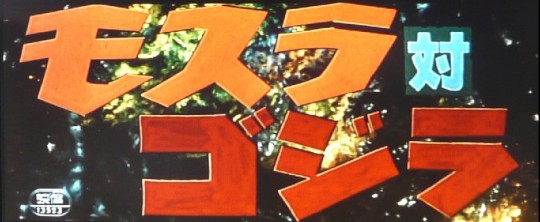

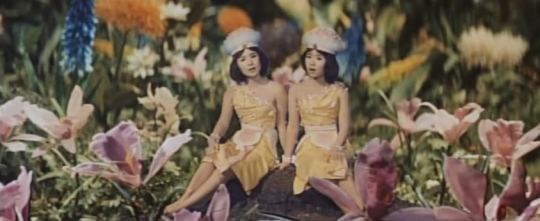
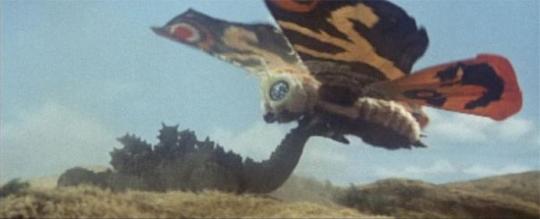
Mothra vs. Godzilla (1964) dir. Ishiro Honda
Contains some spoilers.
“a world built on mutual trust.”
i love Mothra. Mothra is easily my favorite kaiju from the Godzilla canon and has been since i was a kid. there’s something compelling to me about the idea of coexisting with a giant benevolent moth.
Eiji Tsuburaya, who i first became familiar with through Ultraman, did an amazing job with the effects in the film. the Mothra puppets are beautiful and i loved seeing the larvae wriggle around. apparently one of Godzilla’s suit actors briefly caught on fire and just kept moving forward with the scene. that’s nuts! it looks great.
i believe that Mothra vs Godzilla is one of the last times, if not the last time, that we see Godzilla as a primary antagonist during the Showa era. it is kind of interesting to note that Godzilla, in this film, doesn’t emerge as an outright villain— a lot of the damage he causes, at least initially, seems to be incidental, caused by his tail getting caught on something or just by being underfoot. it’s not until the JSDF begins firing at him, attempting to electrocute him, and dropping what appears to be napalm on him that he really directs his anger and violence towards people.
truthfully, the majority of the violence in this film comes from the human characters themselves. the plot is kicked off by human greed: when a mysterious giant egg washes ashore, Kumayama, a sleazy businessman, is quick to claim ownership over it and begins plotting out ways he can use this to generate wealth. the most violent moment in the film occurs between Kumayama and Jiro Torahata, his wealthy financial backer. Kumayama, enraged that he has lost almost all of his money while Torahata has bled him dry, beats the crap out of him. when Kumayama turns his back on him, Torahata shoots him dead. this is the only scene where we see blood and human death!
of course, as is the case with the original 1954 godzilla film, the consequences of nuclear bombing cast a long shadow over the entire plot. before Mothra’s egg washes ashore, a young news photographer, Junko Nakanishi, discovers a substance along the shoreline that turns out to be highly radioactive. Mothra’s fairies explain that their homeland, Infant Island, was destroyed by a-bomb testing. when Nakanishi and two of her colleagues go to infant island to beg the inhabitants for mothra’s help fighting off Godzilla, we see the results of that destruction, and the trio is initially harshly turned away in part because of the inhabitants’ rage at their homeland being used by outsiders as a nuclear testing ground. Godzilla, as we know, continues to stand in as a metaphor for nuclear weaponry. the director, Ishiro Honda, apparently wanted to depict the destruction of infant island in a more graphic way but was limited by budget constraints— in “Ishiro Honda: a life in film, from Godzilla to Kurosawa,” he is quoted as saying, “the first island scene was supposed to be more… realistic… as a director, i should have been more stubborn.” nevertheless, his message is clear.
the film is unfortunately marred for me by the midcentury exoticization of the Pacific. Infant Island, being in the South Pacific, is inhabited by Japanese actors in obvious brownface, some clad in an approximation of woven skirts worn by dancers from a variety of Polynesian cultures, some wearing approximations of feather cloaks worn by royals or chiefs in some Pacific cultures, and a select few wearing something reminiscent of the regalia worn by various Igorot peoples in the Philippines (who, for the record, are not Pacific Islanders). of course, there’s nothing we can do about it now in 2023, but it is something worth noting, and that's really what affected my rating. i will say it did give me great pleasure to see the main characters being scolded by the islanders though.
Mothra vs Godzilla’s strength lies in the latter portion of the film when Godzilla and Mothra really start brawling, and i think it’s worth watching at the very least for that. there’s hope at the core of it, a hope that we can learn from our past as humanity and work to build a better world, that still resonated with me today. in the end, who doesn’t want to see Mothra dragging Godzilla around by his tail?
i watched the film in Japanese with English subtitles.
11 notes
·
View notes
Text
i think that one of my all time favorite OCS might be my dangan oc; Kristabelle Nakanishi
I've been roleplaying for like years now, but we first got into Danganronpa roleplays in like 2021-2022, but it was before I knew anything about it fr (fun facto; Oliver enters fandoms without knowing anything about said fandom, that way they're more like to get more into it by reading into the lore as time progresses)
I'm pretty sure the story was changed around a bit, because we soon started a childhood server, which is where we roleplayed our ocs/characters stories and developed the lore
Kristabelle was traumatized obviously like she's my OC she does NOT get a pass tf
ahe had a younger twin sister, and an older brother, who "died" in that same server, and she also had a girlfriend, who she ran away from because of something she was forced to do
her and her siblings were like test dummies for their father (Oliver stop projecting your daddy issues onto all of your ocNO.) BUT they were also raised assassins at a young age, this adding onto the trauma and abuse for obvious reasons
there was this orphanage that all the kids would go to to hang out, and that's where she met kokichi (and his twin sister, played by the same person), who ended up being her best friend and bonded through the trauma !
there was stitch, mia, sparks, mazuko, charlie/ollie, and kristabelle, as the og original character cast
eventually some bad things happened, and everyone separated, and kristabelle ran away, but not before getting to spend some last times with kokichi, who gave her a matching hairpin to remember each other by
now, this wasn't canon at first, but I had went offline for a bit and came back to the server (killing game) spamming me, like, "KRISTABELLE AND TOGAMI MAKE THEM FOUND FAMILY"
I was like lol why
"they're both rich, they both drink tea, they're both tall and sassy, I'd let them step on me (<-mia), they have a lot in common, theyre both kinda antags, they would be unsTOppable, MAKE THEM FOUND FAMILY." OKAY DAMN
so I did !
obviously they weren't fond of each other at first, but eventually they actually did become like an amazing fucking duo
again this was an alternate universe with a somewhat changed story, not everything will be entirely lore accurate <//3
they both fucked up trials, and almost found themselves being executed because of misunderstandings, took no one's shit fr
i think we merged killing games in this ⁉️ because we didn't wanna do separate ones for every game + we didn't want to necessarily have us in every game, so we put all three together, and oh my god it was so chaotic in the best way, everything was harder and much more hilarious but like traumatizing too
everyone obviously had like amnesia, except for stitch and Junko, who were the main masterminds ⁉️ so kokichi and kristabelle didn't even recognize each other, sadly
when they were kids they were inseparable
THE EXECUTIONS
stitch always came up with the executions for our OCS and they were so creative
I was heartbroken once because someone else's oc died and I liked them like NO⁉️
Oliver is getting off track, but like she's one of my best OCS I think personally, not counting my genshin OCS because then, Kristabelle would NOT be my favorite.
I wrote out
like
four? or three things for her, little snippets of her past and how traumatizing it was
I wrote out a full on death scene I was surprised with myself reading back on it
5 notes
·
View notes
Text
DO NOTHING: The core of urban engineering (2:2/3 Essay)

Encounter with Associate Professor Morimura
Michiyoshi Morimura(道美 森村), an assistant professor (at that time, later a professor), was also one of the people who came to get the stamp. When it comes to city planning, he is unparalleled in his detailed case studies. Mr. Morimura didn't give me a stamp either, but he worried, "Mr. Morishita, is that okay?"
And we had an interesting conversation there. Mr. Morimura: "Mr. Nakanishi (Assistant Junko Nakanishi:準子 中西) is planning a city for sewerage in Komagane City, Nagano Prefecture. I am also interested in city planning for sewerage, so I read the plan. However, there is no DO NOTHING in her plan”. When I heard that word, I realized something,“ Do Nothing. Did that mean? The meaning is very different from what I learned in class. Certainly, Mr. Nakanishi's sewerage plan does not have DO NOTHING. " It's like a Zen question and answer, so I'll explain the above conversation next.
What does DO NOT HIG mean?
In the first place, the word DO NOTHING is a term that always appears in city planning classes, but everyone easily passes by. There is no reason for anyone trying to develop city-related facilities to "do nothing". When I heard this term in class, I also passed by saying, "It's an uncluttered concept." However, this DO NOTHING is the core of urban engineering, and by extension, all academics.
I became interested in environmental issues for the first time since my specialty was decided, and was inspired by Junko Nakanishi's "Urban Revitalization and Sewerage". I was in and out. Around that time, Ms. Nakanishi's "Komagane City Sewerage Plan" came out. By the way, Mr. Ui, who made a name for himself in the accusation of Minamata disease, did not know how to use a can opener. Ms. Nakanishi lived in a high-rise condominium and enjoyed urban life. All have only the perspective of a city citizen. If such a person makes a sewerage plan, he or she will be able to do only uncluttered and half-finished things, if not the worst.
In fact, that's right, and for me, Ms. Nakanishi's plan wasn't enough. When I thought so, the conversation with Associate Professor Morimura instantly taught me the truth of the matter. "A plan that doesn't know to stay is not a plan." Her plan is sloppy in that sewerage construction is the only option. Associate Professor Morimura saw it only with her plan.
A little different example-when you encounter a snowstorm while climbing a winter mountain, the choice of going forward or turning back is life-threatening. Ms. Nakanishi's sewerage plan is exactly this-it only knows what to do. The situation is similar for nuclear power plant construction, dam construction, and river mouth weir construction. All of them have in common that they can proceed without questioning the lifestyle of the urban people. And it don't know to turn back.
To give another example, the pendulum-when it vibrates, it swings to the right and to the left, but it always passes through the middle point. If you stop the vibration, the pendulum will stop at that point. It is a so-called "immovable point". That is what DO NOTHING is all about. It is essential for planners to keep this in mind at all times. This is true of all disciplines. What do you think about DO NOTHING? This is an essential issue for all researcher.
"DO NOTHING", which had no meaning to me in regular classes, was given a new meaning by my own experience and suggestions from Associate Professor Morimura. Even if I could understand the true meaning of this word, it was worthwhile to go to the urban engineering department and eventually to the university.
And it was not in class but in a chat with Associate Professor Morimura that I got this "enlightenment". It was because I was ready to understand and Associate Professor Morimura gave an appropriate explanation. A student who goes to class with a blank slate and somehow takes notes, a professor who gives a lecture without studying anything. Such a class is only harmful. And, unfortunately, it's a common sight in today's college education. Associate Professor Morimura also said: "Current students go to class too much. They should play more."
#do nothing#無為#Lao Tzu#老子#urban engineering#sewerage#city planning#zen#core of urban engineering#Minamata disease#snowstorm#pendulum#enlightenment#Current students go to class too much. They should play more.#Professor Morimura#essay#rei morishita
8 notes
·
View notes
Photo
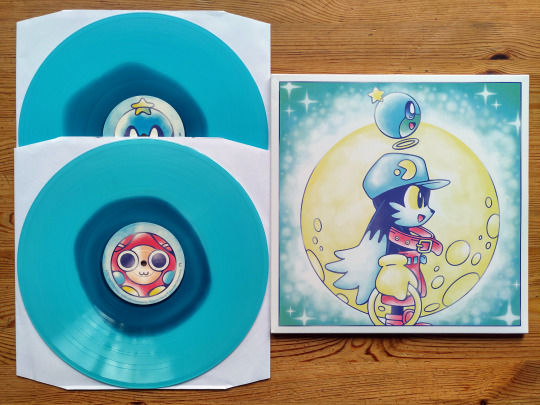



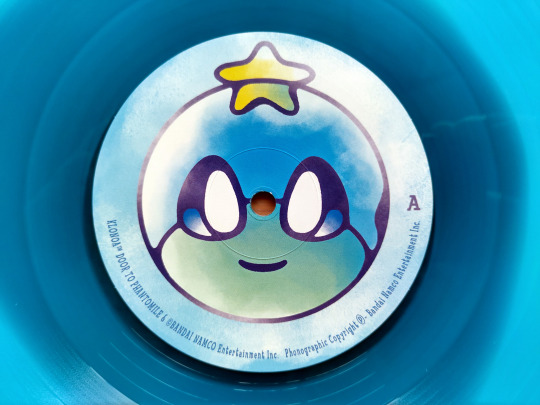





Various Artists - Klonoa: Door To Phantomile Original Soundtrack | Ship To Shore PhonoCo. | 2021 | Blue-In-Light Blue Translucent
#eriko imura#hiroshi okubo#junko ozawa#kanako kakino#kohta takahashi#takaki horigome#tetsukazu nakanishi#tomoko tatsuda#klonoa#door to phantomile#ship to shore phonoco#vinyl#colored vinyl#lp#music#records#record collection#vgm#video game music#soundtrack#namco#drew wise#jeremy parish
107 notes
·
View notes
Text

8 notes
·
View notes
Text
How to tell who composed what song in a Klonoa game
If the song gives you loads of feels, or if it's a leitmotif for someone who isn't a villain, it's Eriko Imura.
If the song is platforming music for a level set in Breezegale or Jugpot, or if it's cutscene music for Ghadius, it's Junko Ozawa.
If the song is really fun and it’s not Junko Ozawa, it's Kanako Kakino.
If the song is really badass, or if it plays in the settings menu, it's Kohta Takahashi.
If the song has anything to do with Joka, or if it has a lot of techno going on, it's Tetsukazu Nakanishi.
If the song is just kinda electronic and ambient and not-that-impressive, it's Hiromi Shibano.
If the song is electronic and ambient and actually quite impressive, it's Go Shiina.
If the song is cutscene music for Seadoph or Granny (“the Chieftess” if you’re playing the Wiimake), it's Takaki Horigome.
If the song is battle music for Nahatomb, it's Hiroshi Okubo.
If the song is either the ending cutscene of Door to Phantomile or its credits, it's Tomoko Tatsuda.
If the song has anything to do with the King of Sorrow or the Ark, or if it's for the Joilant plaza or Jungle Slide, or if it's the sort of thing Eriko Imura would normally compose but she was sick at the time, it's Asuka Sakai.
If the song has anything to do with Volk City, it's Yuji Masubuchi.
If the song has anything to do with Joilant but it's not the main plaza or the Jungle Slide, or if it plays in the Sea of Tears and doesn't fit any of the other composers, or if it has anything to do with Guntz, it's Katsuro Tajima.
6 notes
·
View notes
Photo

Yuriko Hoshi as Junko 'Yoka' Nakanishi.
Promotional photo for Mothra vs. Godzilla (1964).
#yuriko hoshi#mothra vs. godzilla#godzilla vs. the thing#godzilla#toho#me#actresses#photography#yellow
240 notes
·
View notes
Text
Mothra vs. Godzilla (1964)
Journalists Ichiro Sakai and Junko Nakanishi cover the wreckage of a typhoon, discovering an enormous egg has washed ashore. The local villagers claim it and sell it off to unscrupulous entrepreneurs only for Mothra’s fairies to arrive and plead for its return. As the fairies’ requests are denied, Godzilla arises near Nagoya and the people of Infant Island must decide whether they are willing to help the people of Japan against Godzilla.
Trailer film Mothra vs. Godzilla (1964)

source https://bioskop21keren.com/mothra-vs-godzilla-1964/
0 notes
Text
Mothra vs. Godzilla (1964)
Journalists Ichiro Sakai and Junko Nakanishi cover the wreckage of a typhoon, discovering an enormous egg has washed ashore. The local villagers claim it and sell it off to unscrupulous entrepreneurs only for Mothra’s fairies to arrive and plead for its return. As the fairies’ requests are denied, Godzilla arises near Nagoya and the people of Infant Island must decide whether they are willing to help the people of Japan against Godzilla.
Trailer film Mothra vs. Godzilla (1964)

Artikel Mothra vs. Godzilla (1964) pertama kali tampil pada Nonton Film Online IndoXXI.
source http://185.217.95.233/mothra-vs-godzilla-1964/
0 notes
Text
Mothra vs. Godzilla (1964)
Journalists Ichiro Sakai and Junko Nakanishi cover the wreckage of a typhoon, discovering an enormous egg has washed ashore. The local villagers claim it and sell it off to unscrupulous entrepreneurs only for Mothra’s fairies to arrive and plead for its return. As the fairies’ requests are denied, Godzilla arises near Nagoya and the people of Infant Island must decide whether they are willing to help the people of Japan against Godzilla.
Trailer film Mothra vs. Godzilla (1964)

The post Mothra vs. Godzilla (1964) appeared first on Cinema 21 Online Streaming Film Bioskop Indonesia.
source http://80.209.252.54/mothra-vs-godzilla-1964/
0 notes
Text
Mothra vs. Godzilla (1964) Review!

Ishiro Honda returns to direct Mothra in her sophomore outing, this time pairing her with the one and only Godzilla as they share the screen for the first time in their respective histories. When one thinks of the relationship between the two characters, it isn't prototypically adversarial. But much like when comic book super heroes meet in team-up stories, it usually begins contentious, and they soon work it out and band together to ward off the true threat. I suspect we can expect the dynamic of these titans to more resemble that as their relationship evolves through the various continuities in future films, but for this film, they clash, and man, is it awesome.
Echoing the opening of Mothra's self-titled first film, Mothra vs. Godzilla begins with a typhoon causing incredible destruction, this time to Japan's coastline. It's here where I start to see a pattern emerging from the creative exploration of the other through the lens of Japan in this time period. Typhoons are one of the perpetual threats of the country, and seeing it continually associated with these big monster movies makes a certain amount of sense. The disastrous storm washes ashore a gigantic, technicolor egg, which sets the story in motion.
With a title like Mothra vs. Godzilla, we know that the showdown between these strange beasts is what's drawing the audience, so one might expect the focal human characters to take a back seat to the main attraction to at least some degree. Compared to the previous film though, the characters here take an even more ancillary role, though not to say to its detriment, or to say less of the performances. It was a sincere joy to see the return of The Peanuts, Emi and Yumi Ito, to their roles as Mothra's miniature telepathic communicators (presently billed as the Shobijin of Mothra's human-desolated home, the now retconned Infant Island), and in a true return to form, they are just as charming as ever. When they sing Mothra's prayer song in unison, I found myself raising my arms in victory at the sheer excitement of Mothra being called to action through harmonious delight. The Ito sisters are simply fantastic, and I can't write enough about my appreciation of them.
Rounding out the cast are journalists Ichiro Sakai (Akira Takarada), and Junko Nakanishi (Yuriko Hoshi), whose brief, heartfelt speeches to the natives of Infant Island on behalf of the humans endangered by Godzilla's fury resonated convincingly. The villainous duo of Yoshifumi Tajima's Kumayama and Yu Fujiki's Jiro Nakamura successfully play toward another apparently recurring theme of these films as over-zealous, enterprising capitalists who trip over each other in their relentless efforts to appease their single-minded, boundless greed.
Godzilla's attack on Japan showed marked imrpovement in effects quality over the last movie, and the design of his suit here, for me, defines his exemplary look in the Showa era. Mothra dazzles again in bright orange hues, and displays improved maneuverability as the creative team continues to give her more varied actions to perform.
The eponymous battle of these gargantuas is ultimately the star of this show, and the entire fight is wholly enthralling. It's here we get to see Mothra armed with a new power for this movie, and apparently her deadliest one yet (at least according to the Shobijin) - her yellow powder attack. Curiously, while visually exciting, this doesn't seem to do much to Godzilla as he's up again only seconds later, and proceeds to make short work thereafter of our mighty winged protector in her weakened state. It is, however, still nice to see the incremental building of her abilities as we progress through the films.
And with our first on-screen death of Mothra, she is thus born again through her two children who crack out of the bright blue giant egg, and splash on to the scene in their caterpillar forms, ready for the fight that awaits them. After tangling in close-quarters with the bipedal nightmare, the two eventually coordinate their previously established silk attacks, claim victory over the beast in his drowned entrapment, and head back to Infant Island with the miraculously quick-footed Shobijin in toe. (Did the Shobijin really hold on to the backs of Mothra's children the entire way as they swam all the way across the Pacific!?) All's well that ends well as the sun sets on a grateful Japan. Until next time, anyway.
Mothra vs. Godzilla is a movie that lives up to the premiere marquee slobber-knocker it promises. It touches on the ideas and themes its predecessors laid the groundwork for, and grows upon them with blockbuster bravado in its grandiose execution. Seeing these two towering giants of pop culture meet for the first time is a singularly special experience not to be missed by fans of either character.
0 notes
Text
Water and Soil: What is water? (4) (4/6)
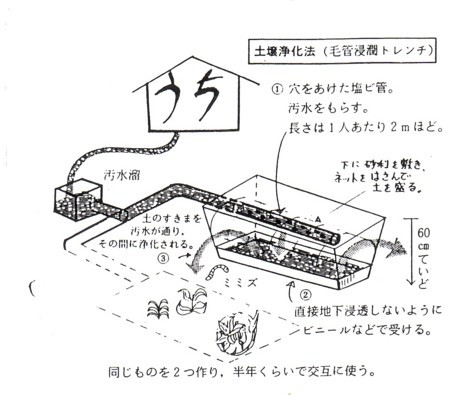
Soil Purification Method
(6 episodes in all, I will post an article I wrote in a mini comic magazine from 1984 to 1985. It is old, but I admit that it still has a certain value. My writing This is an article about training. Episode 4)
‥‥‥‥‥‥‥‥‥‥‥‥‥‥‥‥‥‥‥‥‥‥‥‥‥‥‥‥‥‥
"My elder brother is doing the food, thinking that I am doing sewerage --- the one who goes in, so this one is the one who goes out (stools)." --- My friend S talked to me. This clarity took my breath away. "Well, it's most important of everything." --- At that time, both he and I were in the "water treatment group" that researched Jun Ui's sewerage technology. In other words, I was doing monotonous experiments of boiling and baking sewage all day long.
By the way, the "sewer" is a technology that goes from the hose of the kitchen or toilet to the sea through the sewer pipe and the treatment plant. What we do at the core treatment plant is "water clearance". For example, put miso (Japanese seasoning) in water and stir it. If you leave it for a while, the upper part will become thinner and the mass of miso will sink to the bottom. The treatment plant is very similar to this. The pollutants in the water are "nutrition", and when the soil is put in and stirred, the microorganisms in the soil feed on the nutrients and grow. At this time, a large amount of air is sent in to help their breathing. Next, if left without sending air, microorganisms (called "activated sludge") will settle because they are heavier than water, so the water from the upper will be released. Activated sludge, which is a living thing, is charming because it really turns red miso when it is in good condition. However, there are quite a few things that cannot be removed because they are not big enough to eat anything.
Then, what to do with activated sludge after draining water --- what you borrowed from the soil is returned to the soil --- this is the iron rule, but that is not the case. The current sewerage system is easy to accept not only domestic wastewater but also factory wastewater, and if heavy metals and other harmful substances are mixed in the latter --- activated sludge containing a large amount of it is It is a weak point of sewerage. “Even if it is boiled or baked, it cannot be eaten.” If sludge is incinerated, the area around the chimney will be contaminated with heavy metals. We can't even return it to farmland. Mostly, they are outsourced to a contractor and landfilled or dumped in forests or oceans. (Author's note: Sludge ash containing radioactive substances generated by the Great East Japan Earthquake cannot even do that.) However, the problem is not limited to factories.
A huge pyramid is about to be built on such an uncertain foundation. Regarding "basin sewerage", which treats sewage at the level of one million people a day, there are proceedings against construction in various places, and in reality, many books can be written, but I will not mention much here. (For details, see Junko Nakanishi's "Urban Revitalization and Sewerage" (Nihon Hyoronsha). This is a good book about sewerage full of contradictions.
Actually, what I want to stick to is something more modest. I have vaguely used the word "dirt" in this series so far, but what exactly is this? To put it a little out of the ordinary, isn't it a "flush toilet"? Those that have a two-sided relationship with the benefits of "sewerage". In other words, let's do "dirty things", useless things, and foreign things far away and invisible. That's because I think it's based on the idea that the rest will be somehow. The first half of this idea is the arrogance that "I" has disappeared somewhere. The second half is irresponsible for pushing your luggage against something else. ――― In other words, the “flush toilet” is made up of arrogance and irresponsibility! ――― Is that too much to say? Will the end result be "nothing can be done"?
There is a sewerage technology called "Soil Purification Method". This is a technology that can be made one by one, which is said to be a reaction to the unnecessarily huge sewerage system. Instead of the conventional method of "treating water as water", it is intended to guide water to the basement and purify it with the powerful power of microorganisms, plants, earthworms, etc. in the soil. Since it depends on the power of the soil from the beginning, it seems that the water is actually considerably purified. However, not everything can be shed. For example, synthetic detergent. The soil dies. Also, stool. As I wrote in the first part of this series, soil is relatively incapacitated, and nitric acid, which is decomposed by proteins, causes groundwater pollution. The problem with this stool is the weakness of the soil purification method. (Although it is the whole sewerage system.) With that in mind, I think it is effective if only the wastewater is drained intermittently instead of always emission.
However, the idea of "leading water into the soil" is not perfect. Sure, there is nothing more convenient than soil to suppress odors, but isn't that exactly the "flush toilet"? In that case, I think it is more straightforward to sprinkle water, and like the old farmers, I feel familiar with the idea of using sewage as a fertilizer for the fields, keeping it close to every one. The other is that once you make a fixed device, you tend to overconfide in its ability and start to shed "dirt" as much as you want.
Now again, we have to think about what "sewerage" or "water treatment" is. Sewerage technology can only be completed by connecting water and soil. It's a good fertilizer. And I think that the blessings of that will help grow vegetables that can be eaten with peace of mind. However, does the analysis show that the "dirt" that is currently treated only as a monster can be used as fertilizer? ――― I think there is an infinite gap between “throwing away” and “keeping it alive”.
* * * * * * * * * * * * * * * * * * * * * * * * * * * * * * *
This is my current situation. One of the things I was thinking about when choosing my current apartment was that it wasn't a flush toilet. In reality, it is an apartment with a flush toilet in Koganei City on the Chuo Line. Although I can evade that there were other factors, I am firmly benefiting from the "sewerage". "Am I making something?" --- "…" At best, store the kitchen drainage without draining it, and sprinkle it later. I pee outside as much as I can.(as fertilizer). Fortunately, there is a vacant lot nearby, so I go to fill the vegetable dregs in my spare time. What a modest resistance. What's more, there is a delicious spring water nearby, and at the same time, the breathless "Nogawa(small river flowing nearby)" is flowing. What can i do?
For less than a year, I have been indebted to the neighboring greengrocer "P" in Kokubunji city. Right now, I work part-time at a store number two or three times a week, and I have a lot of fun, but I still have some concerns. It's the destination of yellow leaves and moldy tomatoes. Of course, depending on how you handle it and the understanding of the customer, you don't have to throw it away, and if I have a surplus, I can eat it, so I think this is a big difference from quarters. However, when arranging radishes in a store, I picked up the frost-damaged leaves, casually pushed them into a bag, and brought them to a garbage collection spot. I think this may be a big deal.
(Note: My teacher, Junko Nakanishi, actually called an installer to install this "soil purification method" and tried water quality analysis, and found that there was no water purification effect. )
Postscript: Human activities reduce soil
* * Water gets dirty,
Soil is gone.
Unexpectedly neglected soil (soil) is rarer than water. I made a trial calculation. In the science chronology (1993 edition), the area ratio between land and ocean is 1: 2.42. Also, the average depth of the ocean is
3795m. One-third of the land will be farmland or forest land, and the depth will be 1.5m. Then the amount (volume) of soil
1 * (1/3) * 1.5 = 0.5 (unit)
The amount (volume) of ocean water is
2.42 * 3795 = 9184 (unit)
There is an overwhelming difference.
However, since ocean water is not available, let's calculate the amount of land water, especially river and lake water. For this, we will use the landwater data of "EIC Net". http://www.eic.or.jp/ecoterm/?act=view&serial=2657
2.5% of the water on the earth is fresh water, of which 0.88% is river / lake water.
So fresh water
9184 * (2.5 / 100) = 230 (unit)
River / lake water
230 * (0.88 / 100) = 2.03 (unit), so river / lake water is soil
2.03 / (0.5) = 4.1 (times)
Although the amount of water in rivers and lakes is small compared to the total amount of water, it is about four times as much as soil. Even if the above settings change, the order (digits) will not change. Do you understand that soil is rarer than water? The soil (soil) here is a soil with a rich biota in which crops can be cultivated.
In the past log, I wrote that "pottery reduces soil",
Here, I would like to broaden my perspective and write with the theory that "human activities reduce soil." In the Ashio copper mine incident in the Meiji era, the forest died due to the sulfur dioxide gas emitted from the smelter, the soil flowed out, and the mountain became Bald Mountain. In addition, harmful metals flowed out from the slag to the downstream area, and the rice fields became barren. "Human activity is reducing the soil" wonderfully. In addition, due to the so-called global warming problem, if the sea level rises, the land will be submerged and effective farmland will become unusable. This would also be a practical example of "human activity reducing soil". Oh yeah, one thing that Southeast Asians think is very short-sighted is that they are crushing fine paddy fields and adding seawater to make them "shrimp farms" because "shrimp sell well in Japan." There is. Paddy fields that can surely produce their own food are turned into farms based on Japanese tastes and economic conditions, and they rely on cash income, so they can only be called stupid. And their activity is "reducing soil" by contaminating it with salt. Back in ancient China, how much wood was cut down and burned when making the Terracotta Warriors and Horses of “the First Emperor”(始皇帝). Rough logging leads to desertification ... China's history is certainly desertification ... a history of reducing soil.
Civil engineering and architectural engineering come first in the classification of the departments of the Faculty of Engineering (in the case of the University of Tokyo), but there are probably fewer fields that "reduce soil" as much as these two academic fields. This is also mentioned in the past logs.
Well, unfortunately, I think it is the truth that "soil is reduced" in return for "human activity".
However, as I did at the beginning of this article, "soil is rarer than water." I think that the time when "soil" disappears is the time when humans perish.
In addition, even if you are engaged in farming, you may reduce (kill) the soil. It's time to cultivate chemical fertilizers and pesticides, but when you think about it, the chemical industry intervenes. If you set up a thesis there, it seems that "human activities related to industry reduce soil". I would call this the "human extinction theorem". (By the way, there is a collection of essays by novelist Shichiro Fukasawa called "Song of the Fall of Humans" (Tokuma Shoten). I sympathize with Fukasawa's sensibility.)
* * Water gets dirty,
Soil is gone.
A word of the day: Even in the ancient Chinese thought "Yin-Yang Five Elements", soil is the most important of the five elements of wood, fire, earth, gold, and water (gogyo: the element that makes the world).
3 notes
·
View notes